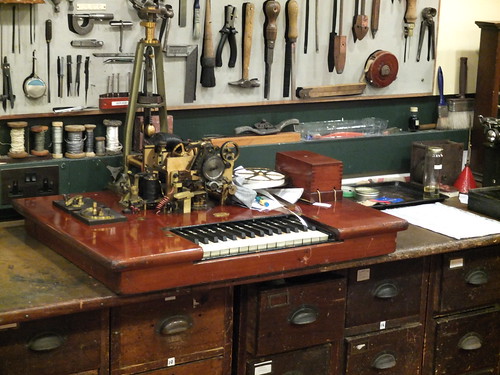
My favourite museum in the whole wide world has to be the Porthcurno Museum of Submarine Telegraphy in Cornwall. Porthcurno has a fascinating history – undersea telegraph cables joined Victorian Britain to the Empire and beyond, coming up on the amazing white beach at the far south west tip of Cornwall. In World War 2 tunnels were driven deep into the rocks because the site was of such strategic importance. The beach was protected by barbed wire and flame-throwers. Its blast and gas-proof doors were guarded by soldiers from Scotland (the thinking being they didn’t know the area and couldn’t be tortured to reveal strategic information). In later years it became the training centre for Cable & Wireless (a bit like Wood Norton is to the BBC).
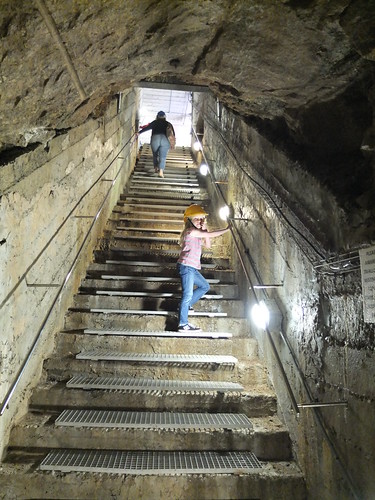
We first went there many years ago, when the museum was smaller and quainter. Almost the only visitors, a lovely old man showed us round the amazing brass telegraph machines, and typed out our eldest son’s name in punched tape on a teletype machine. We also got to go inside the hut on the beach where the actual undersea cables appeared in metal pipes labelled things like ‘Vigo’ – extraordinary to think the other end of the cable was in Portugal.
Now the museum is much more professional, and much busier. This is a good thing, though part of me does yearn for the days when we got a personal tour. Lottery funding means a new visitor centre is being built to cope with the increased numbers.
On our visit this year, we arrived just in time for a great practical demo and talk about the history of telegraphy, with working Wheatstone needle telegraphs, Morse keys and the like. The guide explained why the American Samuel Morse’s binary code was superior to the Brit Wheatstone’s needle telegraph – Morse only needs 2 wires, and you can listen to it clicking or beeping at the receiving end, while you write it down, rather than having to stare at a twitching needle for hours. Morse also invented a printer to make a permanent record of received code – this also meant that the receiving station could be left unattended for period, unlike a Wheatstone receiver.
We then explored the WW2 tunnels, full of marvelous brass telegraph equipment and explanations of how undersea cables were laid, repaired – and in wartime stolen. We climbed the escape hatch, home to nesting swallows, which brings you out on the hilltop with great views of the valley.
All that wonderful old machinery, and a rainy day, got me itching to make a gizmo to create Morse code. I was going to code something from scratch on our Arduino, but I found someone has already done exactly what wanted: http://www.psychicorigami.com/2010/05/26/my-first-arduino-project-morse-code/
The code needed a few tweaks – when I compiled it, I got an error saying that as of Arduino version 1.0 ‘BYTE’ is no longer valid syntax, and to use ‘Serial.write’ instead. I altered 2 lines of the code like this and it seems to work (previous code is commented out)
Serial.write(in);
/* Serial.print(in, BYTE); */
}
else {
Serial.write(-1);
/* Serial.print(-1, BYTE); */

Next, the circuit. I couldn’t see a circuit diagram on the web site, but as luck would have it I had exactly the same Sparkfun Arduino starter kit.
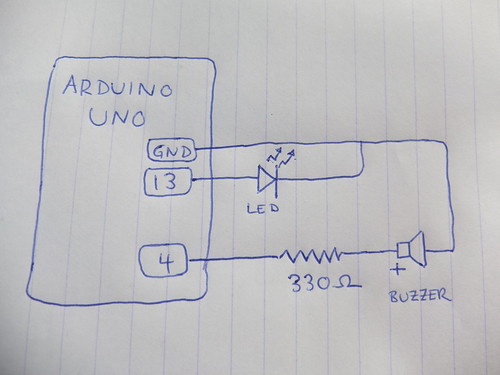
This is how I wired it up: connect Arduino pin 4 via a 330 ohm resistor to the positive terminal of the buzzer. Connect the negative side of the buzzer back via a ground rail to the GND pin on the Arduino next to pin 13. Then connect pin 13 to one side of the LED, and the other side of the LED back to GND via your ground rail.
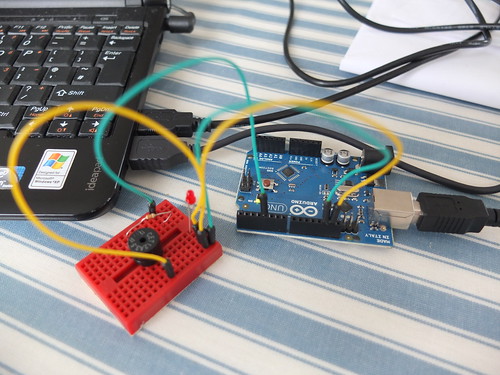
Upload the code to the Arduino, open the serial monitor in the Arduino software, type a message in, press enter – and your message is translated into Morse flashes and beeps!
My dad was a radio ham, and I remember him sending BEST BENT WIRE as it sounds cool in Morse – this is a bit slow to get the sense of the rhythm, so I might try tweaking the code to make it faster. And how cool would it be to get it to read tweets out in Morse…?
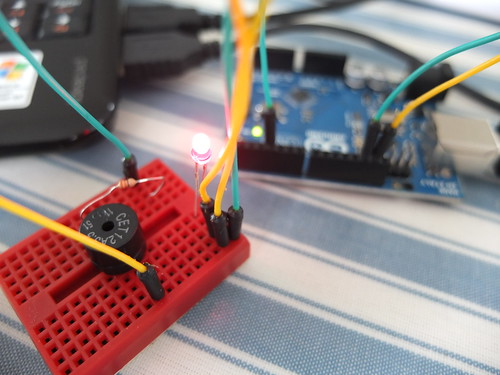
You can see more of my photos of the museum here.

I’d like to be able to get other things talking to the Arduino – I discovered that in the OS X command line I can type
screen /dev/tty.usbmodem1d11(the name of your device after tty. would probably be different) and then I can type on the computer keyboard and the letters will be translated into Morse by the Arduino without running any Arduino software (as described for a different use here). Quite satisfying, though if I force the terminal window to close I then have to reset the Arduino to get it to work again.This might also be a useful resource for getting internet data to my Arduino in the future: http://www.mydarkmaterials.co.uk/2008/11/30/interfacing-php-with-the-arduino/
This looks pretty cool also: http://raronoff.wordpress.com/2010/12/16/morse-endecoder/.
And this might mean I can type text on my Raspberry Pi and get the Arduino to turn it into Morse: http://www.doctormonk.com/2012/04/raspberry-pi-and-arduino.html
The entire phrase to send with Morse Code to amuse and amaze your friends is:
BENS BEST BENT WIRE
It sounds almost musical, especially if you take a few liberties with the cadence when sending the code.
I would love to visit the museum some day.
Yes my dad used to send that to amuse me!
Hello, please can you give me information of receiver telegraph automatic Wheatstone ?
I have send you message with pictures of this receiver.
I have now a complete Wheatstone high speed telegraph system.
Best regards
Michel Balannec
Douarnenez
Britanny
Hi Michel – I don’t have any information apart from what’s in my blog post. You could try contacting Charlotte Todd at the museum? charlotte.todd@telegraphmuseum.org